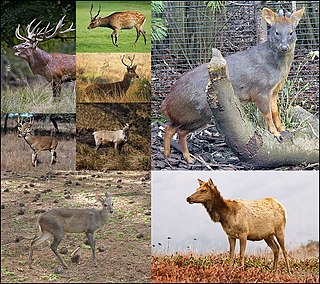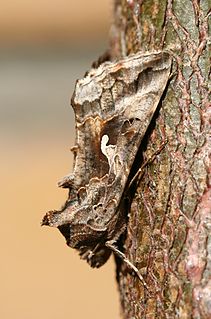| Panchrysia | |
|---|---|
 | |
| Panchrysia v-argenteum | |
| Scientific classification | |
| Kingdom: | |
| Phylum: | |
| Class: | |
| Order: | |
| Family: | |
| Genus: | Panchrysia Hübner, [1821] |
| Synonyms | |
| |
| Panchrysia | |
|---|---|
 | |
| Panchrysia v-argenteum | |
| Scientific classification | |
| Kingdom: | |
| Phylum: | |
| Class: | |
| Order: | |
| Family: | |
| Genus: | Panchrysia Hübner, [1821] |
| Synonyms | |
| |

Equidae is the taxonomic family of horses and related animals, including the extant horses, donkeys, and zebras, and many other species known only from fossils. All extant species are in the genus Equus. Equidae belongs to the order Perissodactyla, which includes the extant tapirs and rhinoceros, and several extinct families.

Eagle is the common name for many large birds of prey of the familia Accipitridae. Eagles belong to several groups of genera, not all of which are closely related. Most of the 60 species of eagle are from Eurasia and Africa. Outside this area, just 14 species can be found—2 in North America, 9 in Central and South America, and 3 in Australia.

Deer are the hoofed ruminant mammals forming the family Cervidae. The two main groups of deer are the Cervinae, including the muntjac, the elk (wapiti), the fallow deer, and the chital; and the Capreolinae, including the reindeer (caribou), the roe deer, and the moose. Female reindeer, and male deer of all species except the Chinese water deer, grow and shed new antlers each year. In this they differ from permanently horned antelope, which are part of a different family (Bovidae) within the same order of even-toed ungulates (Artiodactyla).
A genus is a taxonomic rank used in the biological classification of living and fossil organisms, as well as viruses, in biology. In the hierarchy of biological classification, genus comes above species and below family. In binomial nomenclature, the genus name forms the first part of the binomial species name for each species within the genus.

Binomial nomenclature, also called binominal nomenclature or binary nomenclature, is a formal system of naming species of living things by giving each a name composed of two parts, both of which use Latin grammatical forms, although they can be based on words from other languages. Such a name is called a binomial name, a binomen, binominal name or a scientific name; more informally it is also called a Latin name.

Anseriformes is an order of birds that comprise about 180 living species in three families: Anhimidae, Anseranatidae, and Anatidae, the largest family, which includes over 170 species of waterfowl, among them the ducks, geese, and swans. Most modern species in the order are highly adapted for an aquatic existence at the water surface. With the exception of screamers, all have phalli, a trait that has been lost in the Neoaves. Due to their aquatic nature, most species are web-footed.

Suidae is a family of artiodactyl mammals which are commonly called pigs, hogs or boars. In addition to numerous fossil species, 18 extant species are currently recognized, classified into between four and eight genera. Within this family, the genus Sus includes the domestic pig, Sus scrofa domesticus or Sus domesticus, and many species of wild pig from Europe to the Pacific. Other genera include babirusas and warthogs. All suids, or swine, are native to the Old World, ranging from Asia to Europe and Africa.
In biology, a monotypic taxon is a taxonomic group (taxon) that contains only one immediately subordinate taxon.

In zoological nomenclature, a type species is the species name with which the name of a genus or subgenus is considered to be permanently taxonomically associated, i.e., the species that contains the biological type specimen(s). A similar concept is used for suprageneric groups and called a type genus.

The Pterophoridae or plume moths are a family of Lepidoptera with unusually modified wings. Though they belong to the Apoditrysia like the larger moths and the butterflies, unlike these they are tiny and were formerly included among the assemblage called "microlepidoptera".

Tube-dwelling anemones or ceriantharians look very similar to sea anemones but belong to an entirely different subclass of anthozoans. They are solitary, living buried in soft sediments. Tube anemones live inside and can withdraw into tubes, which are composed of a fibrous material made from secreted mucus and threads of nematocyst-like organelles known as ptychocysts. Ceriantharians were formerly classified in the taxon Ceriantipatharia along with the black corals but have since been moved to their own subclass, Ceriantharia.
The Bronzen Adhemar is the official Flemish Community Cultural Prize for Comics, given to a Flemish comics author for his body of work. It is awarded by the Flemish Ministry of Culture during Strip Turnhout, the major Flemish comics festival, once every two years.

Plusiinae is a smallish subfamily of the moth family Noctuidae. As the Noctuidae appear to be a paraphyletic assemblage, the Plusiinae may eventually be raised to family status.
Arnhem Metal Meeting was a heavy metal festival held in Arnhem, Netherlands in 2004 to 2007. It was booked by TMR Music Promotions and took place at the Musis Sacrum in Arnhem.

In biological classification, taxonomic rank is the relative level of a group of organisms in a taxonomic hierarchy. Examples of taxonomic ranks are species, genus, family, order, class, phylum, kingdom, domain, etc.

Panchrysia v-argenteum is a moth of the family Noctuidae. It is found in the Carpathian mountains, Dalmatia, the Alps and Greece. The species is found high altitudes of up to 1,400 meters.
Holotheria are a diverse group of mammals that are descendants of the last common ancestor of Kuehneotherium and Theria.

Panchrysia ornata is a species of moth of the family Noctuidae. It is found from the Ural Mountains, through Siberia, Mongolia, Sikhote-Alin and the Paektu Mountains to Kamchatka and the Pacific coast. It is found up to altitudes of 2,400 meters.

Panchrysia aurea is a moth of the family Noctuidae. It is found in southern Europe and western and central Asia. The range extends from Portugal, east to Tian Shan, the Altai and the north-western Himalayas. In central Europa, it is found in the southern Alps, lower Austria and the mountains on the Balkan Peninsula.

Panchrysia dives is a moth of the family Noctuidae. It is found from the Ural, east through southern Sibiria to the Pacific Ocean. The range includes Kamchatka, Sakhalin and the Kuriles.
| This Plusiinae-related article is a stub. You can help Wikipedia by expanding it. |